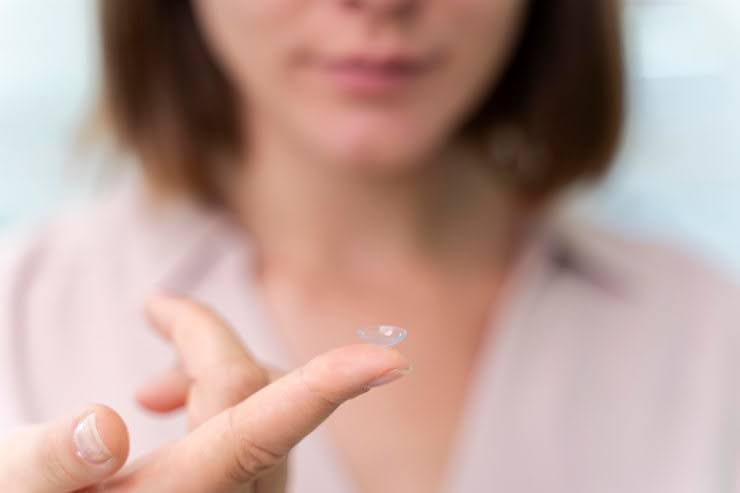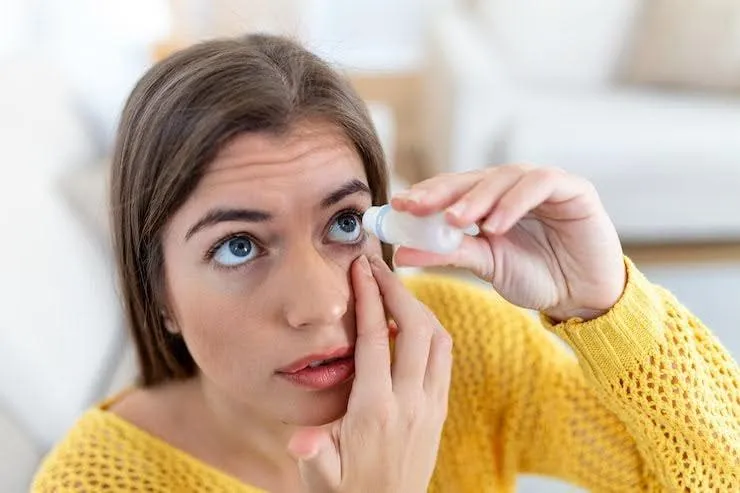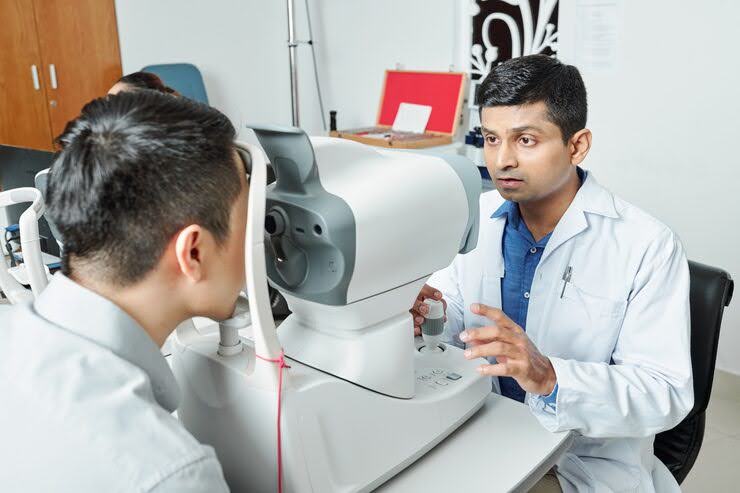Specialty Contacts
Scleral Lens I&R Troubleshooting Guide
FSDAVCFEBFEVSDDVFSD
FSDAVCFEBFEVSDDVFSD
FSDAVCFEBFEVSDDVFSD
Build a Bubble-Free Saline Dome
Start with clean hands—wash thoroughly and dry well. Set up a stable mirror, and place your scleral lens on the plunger or tripod stand. Fill the lens bowl completely with preservative-free saline to the rim, making sure there are no gaps that could trap air bubbles.
Lean forward, hold your eyelids wide, and place the lens straight onto the cornea without tilting. If you see a crescent-shaped bubble or feel a sting, gently remove the lens, refill with fresh saline, and reinsert. Keep the lens rim free from lint and makeup to maintain a proper seal for clear, comfortable wear.
Start with clean hands—wash thoroughly and dry well. Set up a stable mirror, and place your scleral lens on the plunger or tripod stand. Fill the lens bowl completely with preservative-free saline to the rim, making sure there are no gaps that could trap air bubbles.

Lean forward, hold your eyelids wide, and place the lens straight onto the cornea without tilting. If you see a crescent-shaped bubble or feel a sting, gently remove the lens, refill with fresh saline, and reinsert. Keep the lens rim free from lint and makeup to maintain a proper seal for clear, comfortable wear.

Smooth Scleral Lens Removal Without Redness
To remove your scleral lens, look straight ahead and place the small plunger slightly off-center on the lower third of the lens. Gently break the suction by lifting outward and slightly upward—never pinch the lens edge against your eye, as this can cause discomfort or damage. If your eyelids feel tight, applying a lubricating drop before removal can help ease the release process.
After removal, inspect the lens surface for debris or cloudiness. Rinse it with an approved solution, and be sure to clean your lens case thoroughly. Clean handling helps prevent irritation, fogging, and infection—essential for clear, comfortable wear.
If redness appears, note when and where it occurs. Redness right after removal may indicate edge pressure, while redness later in the day might suggest alignment issues. Persistent scleral redness typically means it’s time for a quick fit check and possible minor adjustments. Taking short breaks from lens wear is okay—just be sure to store lenses in fresh, labeled preservative-free solution, never in tap water. When reinserting, fill the lens completely with saline to create a proper seal and avoid bubbles for smooth removal and all-day comfort.
Fixing Scleral Lens Midday Fogging Fast

Midday fogging with scleral lenses usually results from tear film changes, deposits, or micro-leaks around the lens edge. To fix it fast, begin with a controlled refresh: wash your hands, remove the lens, clean it using your approved cleaner, rinse thoroughly, refill with preservative-free saline, and reinsert. Note how long your vision stays clear afterward to help identify patterns.
If the fogging returns quickly, try switching to unit-dose preservative-free saline, reassess your morning cleaning routine, and check for residue such as makeup or lotion on the lens rim.

These small changes often resolve the issue. However, if fogging persists, lens modifications may be needed—such as venting channels, edge lift adjustments, or surface treatments. Bring your lenses, storage case, solutions, and a detailed wear log to your next eye care appointment for a tailored fix to restore clear, comfortable vision.
Scleral redness can result from tight lens edges, trapped debris, or friction caused by dryness. To identify the cause, map your redness patterns carefully. Is it under the lower lid after long screen time or near the nasal area after driving? Pay attention to the onset, location, and severity. Using preservative-free lubricating drops before intense near work and adding a humidifier in dry environments can help reduce irritation and dryness-related redness.
Contact your clinic immediately if you notice pain, discharge, light sensitivity, reduced lens wear time, or recurring scleral lens bubbles. Bringing photos of your redness patterns, along with your lenses, case, and solutions, helps your eye care provider at Kleinwood Vision diagnose the issue more accurately. Often, small adjustments—such as tweaking the haptic zone or surface re-polishing—can restore comfort and clarity without needing a completely new lens. Staying proactive and observant ensures long-term success and comfort with your scleral lenses.
Essential Tools and Clean Habits
Maintain two plungers: a large one for scleral lens insertion and a small one for removal. Use a lighted travel mirror, tissues, and clearly labeled cases to stay organized. Clean your lenses daily with the approved cleaner, rinse thoroughly, and disinfect as directed by your lens brand. Replace cases regularly and avoid cross-contamination by keeping solution bottles capped and upright.
When traveling, bring unit-dose saline vials, backup glasses, and a written care routine to stay consistent. If you drop a lens, flood it with preservative-free saline before handling to protect the delicate surface. Never use tap water on your lenses, scleral plunger, or cases, as it increases the risk of infection. Proper tools and hygiene ensure safe, comfortable wear and help extend the life of your scleral lenses.
At-Home Self-Checks That Save Time
Morning: Confirm a bubble-free lens fit within five minutes of insertion. Bubbles can affect vision and comfort. If any appear, remove the lens, refill with preservative-free saline, and reinsert once. Note the result to track patterns or recurring issues.
Midday: Monitor clarity and comfort throughout the day. If midday fogging scleral issues occur, perform a quick lens refresh—remove, rinse, refill, and reinsert. Log how long your vision remains clear afterward to help identify underlying causes.
Morning: Confirm a bubble-free lens fit within five minutes of insertion. Bubbles can affect vision and comfort. If any appear, remove the lens, refill with preservative-free saline, and reinsert once. Note the result to track patterns or recurring issues.
Midday: Monitor clarity and comfort throughout the day. If midday fogging scleral issues occur, perform a quick lens refresh—remove, rinse, refill, and reinsert. Log how long your vision remains clear afterward to help identify underlying causes.

Evening: Before removing your lenses, check for any edge awareness or signs of scleral redness. This may indicate the need for minor lens adjustments. Clean your lenses thoroughly with the approved solution and allow your lens case to air-dry upside down to prevent contamination and extend its usability.

Evening: Before removing your lenses, check for any edge awareness or signs of scleral redness. This may indicate the need for minor lens adjustments. Clean your lenses thoroughly with the approved solution and allow your lens case to air-dry upside down to prevent contamination and extend its usability.
When to Refit or Reassess the Design
If you experience recurring scleral lens bubbles, daily fogging despite maintaining good hygiene, sector redness, or a noticeable reduction in your daily wear time, it’s essential to schedule a fit review with your eye care professional. These issues often indicate that your lenses may not be fitting correctly or that your ocular surface is reacting to the lenses in ways that affect comfort and vision quality. Early intervention can prevent more serious complications and ensure your lenses continue to provide clear, comfortable wear throughout the day. Specialty Contacts are often the solution in cases requiring more tailored fit or material properties.
When attending your fit review, bring all your current lenses, cleaning solutions, detailed logs of your wear times, and any photos showing patterns of redness, bubbles, or fogging. This detailed information allows your clinician to diagnose problems accurately and make precise adjustments. Common modifications include altering the edge lift or vault of your lenses, or applying surface treatments to improve lens stability and comfort. These adjustments can significantly enhance lens performance without the need for completely new lenses.
If dryness is contributing to your symptoms, discuss additional treatments such as preservative-free lubricating drops, meibomian gland therapy, or anti-inflammatory options. These therapies support a healthier ocular surface, reducing irritation and improving lens tolerance. For those working in dusty or chemical environments, wearing safety eyewear over your scleral lenses can minimize deposits and protect against irritation. Most patients find that small parameter tweaks provide quick relief. Finally, confirm your follow-up schedule and learn to recognize red-flag signs to address problems early and maintain optimal scleral lens comfort and vision.
Patient FAQs: Quick Answers Guide
How long should scleral lens wear last? Many patients reach 10–14 hours daily with proper fit, care, and hygiene. If wear time decreases or discomfort begins, check with your provider. Which saline is best? Use preservative-free unit-dose saline unless your doctor advises otherwise. It helps protect the eye and maintain lens function. Can I use wetting drops over lenses? Yes—only use doctor-approved, preservative-free drops to avoid irritation or damage.
What if I lose a plunger? Keep a spare in your lens kit; some pharmacies and eye clinics stock replacements.

How long should scleral lens wear last? Many patients reach 10–14 hours daily with proper fit, care, and hygiene. If wear time decreases or discomfort begins, check with your provider. Which saline is best? Use preservative-free unit-dose saline unless your doctor advises otherwise. It helps protect the eye and maintain lens function. Can I use wetting drops over lenses? Yes—only use doctor-approved, preservative-free drops to avoid irritation or damage.
What if I lose a plunger? Keep a spare in your lens kit; some pharmacies and eye clinics stock replacements Don’t delay care because of a missing tool. Can I wear lenses swimming? No—avoid swimming with lenses. Use sealed goggles or switch to glasses to prevent contamination.
Don’t delay care because of a missing tool. Can I wear lenses swimming? No—avoid swimming with lenses. Use sealed goggles or switch to glasses to prevent contamination.
After swimming? Always remove lenses, clean them properly, and refill with fresh saline before reinserting. Water exposure increases infection risk. Proper care supports healthy, consistent wear and long-term comfort with your lenses.
After swimming? Always remove lenses, clean them properly, and refill with fresh saline before reinserting. Water exposure increases infection risk. Proper care supports healthy, consistent wear and long-term comfort with your lenses.
Your Daily Scleral Lens Care Routine
Morning: Start your day by inserting your scleral lenses bubble-free. Within five minutes, check for comfort and clarity, and log your results to track consistency over time. A clear, comfortable fit in the morning sets the stage for a successful day of wear. Keeping this part of your routine consistent helps identify issues early and avoid discomfort later in the day.
Evening: Gently remove your lenses, clean all surfaces thoroughly with the approved solution, and inspect for any deposits or edge damage. Always maintain case hygiene by rinsing and letting it air-dry upside down. Keep a troubleshooting card by your mirror to make your routine second nature, even during busy times. If problems repeat for three days in a row, stop guessing—contact Kleinwood Vision with your wear log and photos. For additional help or questions, contact us. Timely, precise tweaks can quickly restore crystal-clear, comfortable scleral lens wear.

Contact Info
Hours of Operation
Mon - Fri | 9:00 AM - 5:00 PM
Sat - Sun | Closed
Holiday Hours: We are closed for the following holidays: New Years Day, Memorial Day, Independence Day, Labor Day, Thanksgiving Day, Christmas Day
© 2025 Kleinwood Vision. All rights Reserved.


